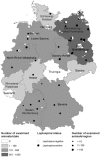Leptospira spp. in rodents and shrews in Germany
- PMID: 25062275
- PMCID: PMC4143818
- DOI: 10.3390/ijerph110807562
Leptospira spp. in rodents and shrews in Germany
Abstract
Leptospirosis is an acute, febrile disease occurring in humans and animals worldwide. Leptospira spp. are usually transmitted through direct or indirect contact with the urine of infected reservoir animals. Among wildlife species, rodents act as the most important reservoir for both human and animal infection. To gain a better understanding of the occurrence and distribution of pathogenic leptospires in rodent and shrew populations in Germany, kidney specimens of 2973 animals from 11 of the 16 federal states were examined by PCR. Rodent species captured included five murine species (family Muridae), six vole species (family Cricetidae) and six shrew species (family Soricidae). The most abundantly trapped animals were representatives of the rodent species Apodemus flavicollis, Clethrionomys glareolus and Microtus agrestis. Leptospiral DNA was amplified in 10% of all animals originating from eight of the 11 federal states. The highest carrier rate was found in Microtus spp. (13%), followed by Apodemus spp. (11%) and Clethrionomys spp. (6%). The most common Leptospira genomospecies determined by duplex PCR was L. kirschneri, followed by L. interrogans and L. borgpetersenii; all identified by single locus sequence typing (SLST). Representatives of the shrew species were also carriers of Leptospira spp. In 20% of Crocidura spp. and 6% of the Sorex spp. leptospiral DNA was detected. Here, only the pathogenic genomospecies L. kirschneri was identified.
Figures

Similar articles
-
Prevalence and Genotype Allocation of Pathogenic Leptospira Species in Small Mammals from Various Habitat Types in Germany.PLoS Negl Trop Dis. 2016 Mar 25;10(3):e0004501. doi: 10.1371/journal.pntd.0004501. eCollection 2016 Mar. PLoS Negl Trop Dis. 2016. PMID: 27015596 Free PMC article.
-
Leptospira Genomospecies and Sequence Type Prevalence in Small Mammal Populations in Germany.Vector Borne Zoonotic Dis. 2018 Apr;18(4):188-199. doi: 10.1089/vbz.2017.2140. Epub 2018 Feb 22. Vector Borne Zoonotic Dis. 2018. PMID: 29470107
-
Leptospira spp. in Rodents and Shrews from Afghanistan.J Wildl Dis. 2019 Apr;55(2):477-481. doi: 10.7589/2018-05-122. Epub 2018 Oct 30. J Wildl Dis. 2019. PMID: 30376394
-
Outbreak of Intermediate Species Leptospira venezuelensis Spread by Rodents to Cows and Humans in L. interrogans-Endemic Region, Venezuela.Emerg Infect Dis. 2024 Aug;30(8):1514-1522. doi: 10.3201/eid3008.231562. Emerg Infect Dis. 2024. PMID: 39043385 Free PMC article. Review.
-
Leptospira species infection in cats: ABCD guidelines on prevention and management.J Feline Med Surg. 2013 Jul;15(7):576-81. doi: 10.1177/1098612X13489217. J Feline Med Surg. 2013. PMID: 23813819 Free PMC article. Review.
Cited by
-
Tracking potential Leptospira sources following human cases of leptospirosis: A One Health approach applied to an ecosystem in Brittany, France.One Health. 2024 Apr 6;18:100726. doi: 10.1016/j.onehlt.2024.100726. eCollection 2024 Jun. One Health. 2024. PMID: 38644972 Free PMC article.
-
Spatio-temporal trends in richness and persistence of bacterial communities in decline-phase water vole populations.Sci Rep. 2020 Jun 11;10(1):9506. doi: 10.1038/s41598-020-66107-5. Sci Rep. 2020. PMID: 32528097 Free PMC article.
-
Prevalence and Genotype Allocation of Pathogenic Leptospira Species in Small Mammals from Various Habitat Types in Germany.PLoS Negl Trop Dis. 2016 Mar 25;10(3):e0004501. doi: 10.1371/journal.pntd.0004501. eCollection 2016 Mar. PLoS Negl Trop Dis. 2016. PMID: 27015596 Free PMC article.
-
Identification of Pathogenic Leptospira kirschneri Serogroup Grippotyphosa in Water Voles (Arvicola terrestris) from Ruminant Pastures in Puy-de-Dôme, Central France.Pathogens. 2023 Feb 6;12(2):260. doi: 10.3390/pathogens12020260. Pathogens. 2023. PMID: 36839532 Free PMC article.
-
Pathogenic Leptospira Infections in Hubei Province, Central China.Microorganisms. 2022 Dec 30;11(1):99. doi: 10.3390/microorganisms11010099. Microorganisms. 2022. PMID: 36677392 Free PMC article.
References
-
- Bharti A.R., Nally J.E., Ricaldi J.N., Matthias M.A., Diaz M.M., Lovett M.A., Levett P.N., Gilman R.H., Willig M.R., Gotuzzo E., Vinetz J.M. Peru—United States Leptospirosis Consortium. Leptospirosis: A zoonotic disease of global importance. Lancet Infect. Dis. 2003;3:757–771. doi: 10.1016/S1473-3099(03)00830-2. - DOI - PubMed
-
- Faine S., Adler B., Bolin C., Perolat P. Leptospira and Leptospirosis. MediSci; Melbourne, Australia: 1999. pp. 83–86.
-
- Robert Koch Institute [(accessed on 15 July 2014)]. Available online: https://www3.rki.de/survstat/
Publication types
MeSH terms
Substances
LinkOut - more resources
Full Text Sources
Other Literature Sources
Miscellaneous

